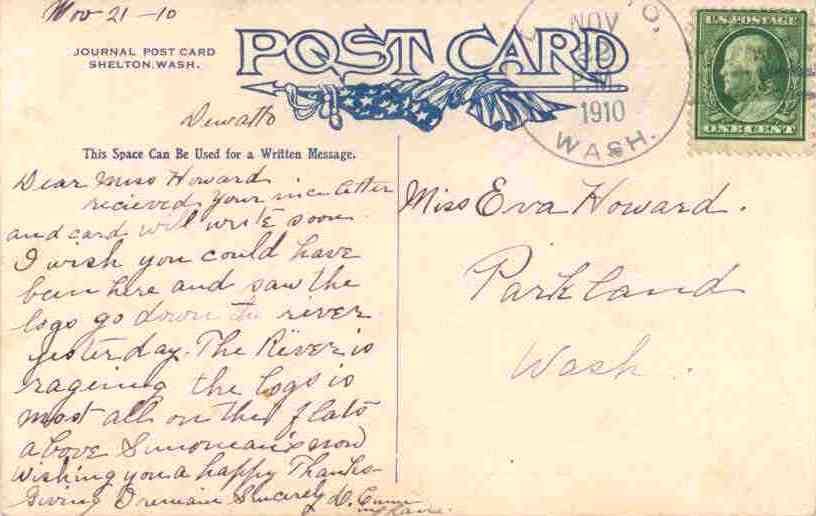 |
| Spiral Bridge ~ Hastings, Minnesota |
Postcard Talk
Is the Forerunner of the Cloverleaf Bridge in Hastings Minnesota???
This article written by Mary Katherine May of
QualityMusicandBooks.com.
I generally don't add unused postcards to my collection. On one of last week's searches for Minnesota and surrounding states postcards (a.k.a. the Mid-Midwest), however, this postcard caught my attention. It wasn't only the intense colors, but also the shape of the bridge.
This bridge is NOT a
cloverleaf interchange, though that was the first thought that came to me. I looked it up. The Spiral Bridge pictured on this postcard was erected in 1894. The first cloverleaf bridge interchanges came along about twenty years later. Did someone see a photograph or image of the bridge in Hastings? Without knowing for certain, speculation is always an option. Maybe an engineer saw it and thought,
"Hey! Why don't I just take this loop, loop four times and...Well, by golly! It's a cloverleaf!
Even without the message there is a lot of history to be learned from this postcard. Most of what I could tell you, however, has been told quite well on other sites. I have made an executive decision about it, and this time am giving the short synopsis version with links.
Spiral Bridge, Hastings, Minnesota
There are quite a few sites that offer information about this unique bridge--why it was built, the impact it had on Hastings as a point of interest, how long the bridge was used and its current status.
History of the
Spiral Bridge
Hastings is a great place for its
many historic buildings and sites, including the Spiral Bridge.
A replica of the bridge can be viewed at
Little Log House Pioneer Village near Hastings.
Minneapolis StarTribune article about the new bridge that replaced the Spiral Bridge.
 |
| Meloy Park ~ Hastings, Minnesota |
Meloy Park
John C. Meloy, born in Cambria County, Pennsylvania, settled in
Hastings, Minnesota in 1856, before Minnesota entered the Union (1858). The river port in Hastings was one of the stopping points before traveling north to Fort Snelling. In the lower right area of the postcard, there is an arched entry into the park named for Mr. Meloy, whose location is below the Spiral Bridge.
The Beginnings of Hastings, Minnesota History: First Hand Accounts
In my years of study, I have always found that learning about the past is at its most fascinating when reading
first hand accounts.
Though the back of this postcard is blank except for a brief comment written with fountain pen, there is still historic information of interest. On the left edge of the card, we read that this postcard was
Made in Germany. This tells us that it was
printed before World War I. Studying the affects war has on all aspects of life is a good lesson learned for both the present and the future.
In the same area is stated that this card was published by
J. G. Sieben, Hastings, Minnesota. Who was J. G. Sieben? What did he do in Hastings? What role did Mr. Sieben's family play in Minnesota? These are all good questions with application to learning about how history impacts the future. As it turns out, J. G. Sieben, who went by the name George, and other members of his family did impact both Hastings and Minnesota history. For instance, they served their city and state by taking active roles in political and relevant social projects and issues. J.G. was a druggist, photographer, mayor of hastings three times, husband and father, and active in his church.
Also on the postcard back is a Litho-Chrome logo. If you do much research with old documents, you will understand how knowing about printing and paper helps in identification depending upon the era or century.
This postcard was printed using a process called
Litho-Chrome (scroll down the page).
MetroPostcard.com, site for the Metropolitan Postcard Club of New York City, is an impressive excellent reference and learning site. The page link describes litho-chrome printing (and other printing processes):
A German made card printed in blue collotype over red and yellow spatter. It explains the color, too. So I cropped out a part of the postcard image to look for the spatter. Can you see the spatter?
There isn't much more to see that is obvious except for one last detail, which is the stamp box. It is an advantage with unused postcards because of being able to see the stamp box with printing. This one states: Postage United States and
http://en.wikipedia.org/wiki/Bureau_of_Insular_Affairs, Cuba, Canada, and Mexico ONE CENT. For all other Countries TWO CENTS.
A few hours looking around, asking obvious questions, has been not only entertaining but educational. I have been to Hastings a few times, not too far south of the Twin Cities of Minneapolis and St. Paul. It just may be time for another, more in-depth visit!


































